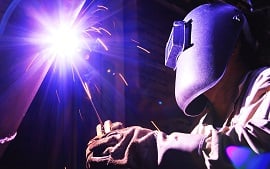Should I become a welder? What is the work like?
Welding is a method of providing a high strength joint in metallic components. It does this by melting metal to form a bridge between the parts to be joined.A large amount of welding is done by manual techniques, where an electric arc or a gas flame is used to melt the metal in the joint.
The welder is therefore in direct control of the process, making judgements that decide the quality of the finished joint.
The 4 Main Manual Welding Processes.
These are called Manual Metal Arc welding (MMA), Tungsten Inert Gas welding (TIG), Metal Inert Gas welding (MIG) and Oxy-acetylene welding (OA).
Each has its own field of application, but they all require a high degree of skill to achieve sound welds.
Mechanised Welding.
Some techniques are mechanised, where many welds requiring exactly the same result are required. This occurs in the volume production of, say, cars or washing machines.
The skill required in this type of welding lies in the setting up of the control system, and is usually the responsibility of a technician. In this instance, the welder would operate the machine.
Why Choose Welding?
Welding is one of the few remaining skills used in manufacturing and construction.
As the quality of the weld depends on the skill of the welder, you can take a pride in your work as a craftsman, and have a sense of achievement.
There is also the continuing challenge of developing new skills to meet different situations.
Also, welding is a transferable skill, it is not confined to one industry or one country.
Welders are required for applications as diverse as jet engine manufacture and bridge building, to laying pipelines and fabricating equipment in special materials like Cobalt.
Welding skills and qualifications obtained in the UK are equally in demand in Europe and the rest of the world.
What Skills or Interests Do You Need?
Most people can learn the essentials of welding, but not everyone can develop the skills needed to consistently meet the standards required by modern industry.
To start with, a welder needs good eyesight and must be physically fit. You must have patience and be able to persevere – it takes a lot of practice to become a good welder.
Welding demands undivided attention for periods of up to five minutes.
Any variations in the operation of the system must be observed and translated into immediate corrective movements of the hand. This is often referred to as hand-eye co-ordination.
If you are good with your hands and enjoy working with tools, you would probably be able to respond to welder training.
Finally, you would need to gain an understanding of the tasks that you perform. So you must be able to learn about the technology used in the welding processes.
Are There Hazards in Welding?
There are hazards; the processes use heat to melt metal, so there is a risk of burns.
The ‘arc’ of the welding instrument produces fumes and a bright light, both of which can be injurious to the welder and other workers.
There are also the usual hazards associated with working with electrical equipment.
However, there are well defined working procedures protecting the welder/operator against these risks.
If these procedures are followed, there is no reason why welding should be any more hazardous than other occupations in engineering. Safety first!
Are you still keen to find out more?
Follow this link to a NEW idea from one of the UK’s leading metal fabricators.
JCB have launched a school for young Engineers, who can attend from the age of 14.
Many people prefer to learn with a “hands on” approach, and here you can at the JCB Academy.

Take a look at this blog page with this amazing Infographic we created on the Most Dangerous Jobs.


